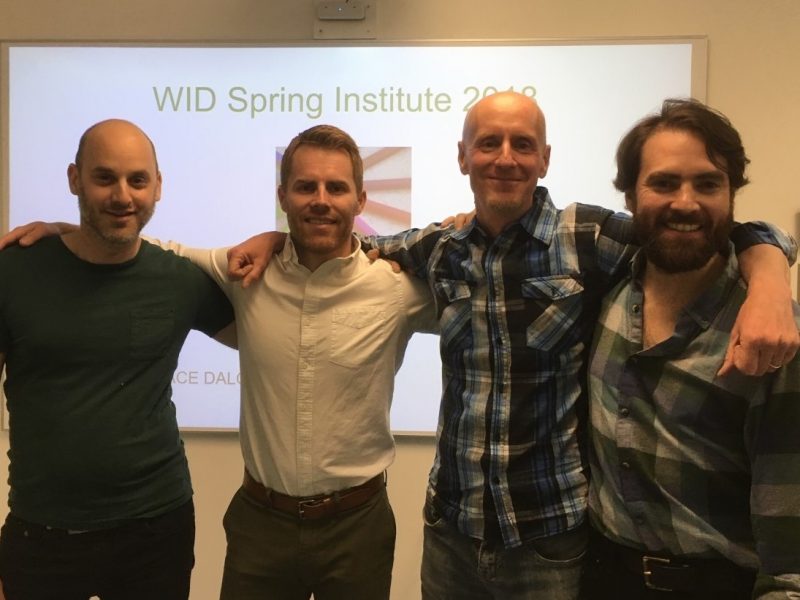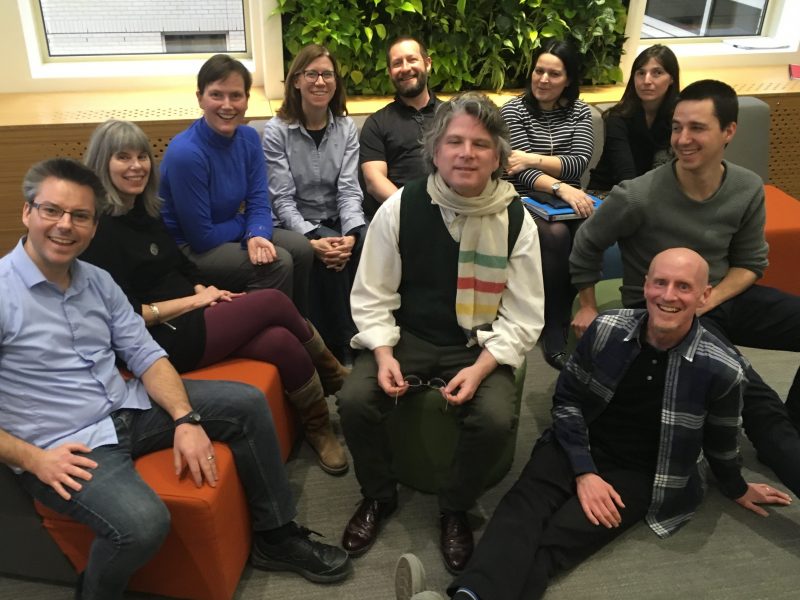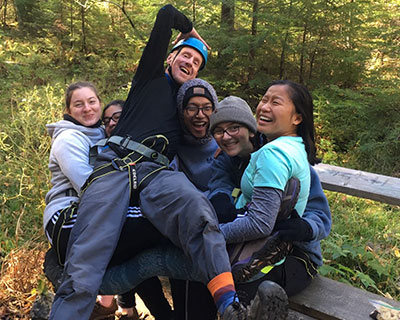Ian MacKenzie’s work has “transformed the classrooms, programs, and even the academic culture” of Dawson College.
These words come from the official nomination of Ian MacKenzie for the 2020 SALTISE Best Practices & Pedagogical Innovators Award. Ian has taught English at Dawson since 1992 and over the years has contributed in many ways to the life and mission of the College.
Promotion of student learning

The 2020 Award Selection Committee was impressed by Ian’s deep commitment to students and colleagues at Dawson, and his promotion of student learning through pedagogical innovation, in particular his leadership of Dawson’s Writing in the Disciplines and Learning Communities initiatives.
In 2010, after several years of preliminary research and preparation with a group of colleagues, Ian launched Dawson’s Writing in the Disciplines. Since then, WID has inspired, guided and supported hundreds of faculty members by way of the Faculty Writing Fellows, Department and Program WID Projects, and the annual WID Spring Institute. Through these WID activities, teachers are introduced to evidence-based approaches to writing, critical thinking and active learning, and connected to each other through a community of practice that has seeded a culture change in writing instruction across departments.
Award is an encouragement to other innovators
“The idea of an award seems a wee bit out of synch with our current situation, unless we are talking about awards for frontline healthcare providers and other essential workers,” Ian said a few days after learning of the honour on May 15. “At the same time, any good news is welcome news. I think the SALTISE awards are most important as a positive signal to other innovators, at Dawson and throughout the CEGEP network, encouraging anyone with a good idea to get to work – to create a network of like-minded collaborators, to side-step the nay-sayers, and to start advancing step-by-step toward their shared vision.”
Ian wished to particularly acknowledge the contributions of Liz Charles (SALTISE) and Chris Whittaker (DALC). “As I look back over the past ten years, it is obvious how we really have been working in parallel, often sharing ideas, and always spurring each other on,” Ian said. “When people who are motivated to innovate support each other, many impossible things become possible.”
He also pointed out that while an award might give the impression that these projects are personality-driven, almost from their inception they advance through collaboration. “Without a team, as Chris and Liz know, you have a one-wheeled go-kart. From the start, I have been lucky to work with many great colleagues on these projects – in WID, with Anne Thorpe as the original co-lead and now with Jeff Gandell, who has taken over the Writing Fellows, and in Learning Communities with Chris Adam and Rob Cassidy – and sorry, I’m passing over many many others!”
Improving the teaching of writing
By the mid-2000s, there was a renewed, teacher-driven interest in improving student writing at Dawson. Building on lessons learned from the mid-90s Literacy Across the Curriculum project led by Linda Shohet, the goal of WID was to improve instruction by introducing faculty to a range of best practices, drawing on the writing-across-the-curriculum (WAC) literature. “Contrary to what you read sometimes in the media, high schools do not graduate “illiterate” students. Students do not come to college not knowing how to read and write. But they are definitely challenged by a range of complex, unfamiliar disciplinary tasks. College students are novices; they need effective coaching in reading, thinking, writing and arguing in specific academic genres. They don’t know the argumentative “moves” particular to Economics or Philosophy or a scientific article,” Ian said. “Thus the need for effective discipline-specific approaches.”
Research in disciplinary genres and argumentation over the past 30 years has resulted in numerous writing-in-the-disciplines (WID) programs at colleges and universities across North America.
“It was very attractive to me that WID was evidence-based,” Ian said. “There was already a wide and deep literature, and a very active and accessible scholarly community, including people at McGill like Anthony Paré and Doreen Stake-Meyerring.”
After identifying several exemplar programs, teachers from Dawson visited WID programs at Cornell University and the University of Vermont in Burlington to exchange ideas and gather inspiration. “Working with more people from across our own departments, we then developed something quite Dawson-specific, but based on the best ideas and proven models from elsewhere,” he said.

WID Spring Institute 2018 facilitators Jeff Gandell, Tim Miller, Ian, Joel Trudeau
Over the past 10 years, WID has had many direct and indirect positive impacts
- Putting teachers who are interested in professional growth and education research in touch with each other, spurring further collaborations
- Inspiring other Dawson communities of practice and their leads
- Making Dawson a unique CEGEP with a diverse culture of faculty-driven professional development
“Both WID and DALC (Dawson Active Learning Community) blazed a path forward and demonstrated to others that this was a fruitful investment of time and energy. We confirmed that these initiatives could find institutional support and could provide concrete returns on investment in terms of improved instruction and faculty professional growth,” Ian said. He also emphasized the importance today of Dawson’s transformed Office of Academic Development, which is rapidly developing new ways of supporting the work of the communities of practice and complementing what they offer through the new Faculty Hub.
Integrating knowledge across disciplines
Ian was also honoured for his work on the Learning Communities project, which has created opportunities for teachers to co-design and co-teach paired and stand-alone interdisciplinary courses. Driving this initiative is the goal of giving students the opportunity to practice the integration of knowledge across disciplines.
Ian gave an example of a Social Science Research Methods course paired with an Introduction to Geography course. “The two teachers, Mark Beauchamp and Geoff Pearce, worked together to design the courses and taught them back to back. Students learned how to use oral history methodologies and then applied them to a project studying the evolution of the urban neighbourhood of Shaughnessy Village. This was a bona fide interdisciplinary research experience for the students; their interviews have been integrated with the larger Montreal Oral History Project run out of Concordia’s Centre for Oral History.”
Dawson is on track to offer 30 paired and team-taught courses in 2020-21, and there is interest from a variety of programs and certificates in adding more. The strategic planning process of Winter 2019 produced a three-year plan that will guide new developments through 2022.

W2018 Learning Community project development teams
Desire to tackle real problems
Students today are seeking authenticity, according to Ian. “Students want to tackle real problems, and direct their own learning,” Ian said. “If given a choice, they will almost always choose authentic, self-directed inquiry over a generic transmission-regurgitation program of learning.”
One of the WID department projects a few years ago, in Physics, is a good example. Nadim Boukhira and Jean-François Brière started the project to investigate ways of making physics labs less “cookbook,” and more authentic scientific inquiry.
“They conducted several student focus groups, and learned that simply following canned lab procedurals and filling in handouts wasn’t very exciting – and no one felt that the experience resembled real scientific experimentation,” Ian said. “So, Jean-François and Nadim proceeded to design several new labs with a focus on uncertainty and error, in which the outcomes were not pre-baked, and where the evaluation emphasized rigour in assessing error and uncertainty, versus arriving at a pre-determined right answer.”
What’s next for Ian?
“I’m doing a lot of stuff right now that I am really enjoying,” he said, mentioning an English Literary Themes course, Into the Wild, which is paired with a Physical Education course, Nature Retreat, taught by Doug Smyth.
This Learning Communities pairing connects an introduction to the North American tradition of nature writing with an outdoor education course designed to give students the skills and confidence to enjoy traditional outdoor pursuits like canoeing and hiking. The goal is to stimulate a healthier human relationship with the natural world.
“We take the students on two trips: an overnight camping trip and a daylong hiking trip. Over the semester they learn about outdoor skills and the stewardship mindset, and at the same time see those skills and attitudes reflected in our readings on nature and the environment,” Ian said. “It’s a fantastic integrative combo, in theory and in practice. The students love it; it is a transformative experience for many of them. And Doug and I agree, it’s a blast to teach.”
Ian believes that initiatives like this point towards the future of learning. “The biggest problems in the world today – the climate crisis is an obvious and pressing example – demand an interdisciplinary approach, integrative skills and a collaborative mindset. We can and must begin equipping students to address these kinds of challenges.”
Pandemic requires collaborative thinking
The current COVID-19 pandemic only highlights how complex, wicked problems require a strong set of critical thinking and communication skills, practiced by necessity through collaborative virtual platforms.
“A vaccine will not likely be “discovered” by any one individual,” Ian said. “It will more likely emerge from a self-organizing, global effort in research, collaboration, and communication involving countless individuals and teams. We should be thinking about how our students could be learning in ways that simulate this reality.”
Greater awareness of active learning benefits
Since Ian began teaching, progressive student-centred ideas about learning have steadily been gaining influence.“These ideas are so widely diffused today that no one can claim ignorance as a justification for sticking strictly to a teacher-centred, content-transmission approach,” Ian said. “I’d be surprised today to meet a Dawson instructor who has never heard of active learning. In reality, more and more teachers are aware that the literature is unequivocal regarding the advantages of active learning pedagogies.”
“The steady increase in demand for active learning classrooms at Dawson, for example, is a good indicator of how faculty awareness is driving change.”



